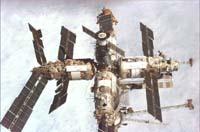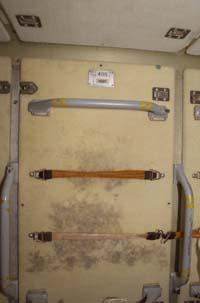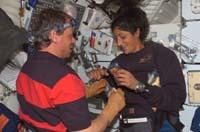The house in order, especially in the space

In the Russian space station all kinds of microorganisms were growing. (Picture: ANDÉN)
What's more, in space, cleaning is especially important. For this reason, spacecraft leave almost sterilized from Earth, and astronauts must constantly take care to immediately remove the slightest trace of dirt.
But when he goes where he goes, man always carries microorganisms with him, and his eradication is not easy. In the Russian space station MIR, for example, it was clear, as demonstrated by NASA.
Of all kinds
In the late 1990s, NASA participated in a microorganism analysis program of the MIR station. In fact, NASA wanted to investigate which microorganisms can grow in long-lasting missions and considered that the MIR space station could be a good place for it.

In the International Space Station of Fungi, a panel in which clothes hang after exercise. (Photo: ANDÉN)
In fact, the MIR station spent 15 years in the Earth's orbit, during which time the electricity was cut off on several occasions. Consequently, in some sections the temperature and humidity were higher than necessary, ideal conditions for the growth of microorganisms.
Thus, in 1998, American astronauts made a couple of visits to the MIR and took samples of air and skin in all corners of the MIR: control center, dining room, rooms, toilets, gym and scientific analysis tools.
From the beginning they realized that very diverse microorganisms would be found. In fact, by removing several panels from the sampling station, they found the water balloons hidden behind them. Apparently, with time the humidity was condensed and the drops joined due to microgravity. If the air currents dragged the water back from the panels, it was trapped.
At the back of the panels there was a temperature of 28 °C, ideal for the growth of microorganisms and fungi. Therefore, as expected, in those samples found everything: bacteria, fungi, protozoa, mites... In addition, numerous colonies of microorganisms were found in the space garments, window rubber seals, cable insulators and pipes, as well as in the communication equipment.
LOCATE-PTS

Astronauts must cleanse everything perfectly, since otherwise they can get sick. (Photo: ANDÉN)
However, microorganisms not only grew in MIR, but are also found in the International Space Station (ISS). And they are dangerous both for the health of astronauts and for the structure of spacecraft. Among other things, they can cause corrosion in the bonding zones of two different materials, form acids that destroy metal, glass and rubber and damage water and air filters.
To prevent these problems, NASA engineers are developing a fast, portable microorganism detection laboratory. The tool, called LOCAD-PTS, is able to inform within minutes of the existence and nature of microorganisms on any surface or air.
In the conventional method, the samples collected are taken to the laboratory, where they are placed in different culture media. Then they are stored in the growth furnaces and after going from 24 to 36 hours at high temperature, check their growth. The new tool, for its part, will have a practically immediate result. It seems to be a breakthrough for astronauts. To see if the house washes invent something so that they are not so heavy!
Published in 7K.
Buletina
Bidali zure helbide elektronikoa eta jaso asteroko buletina zure sarrera-ontzian











